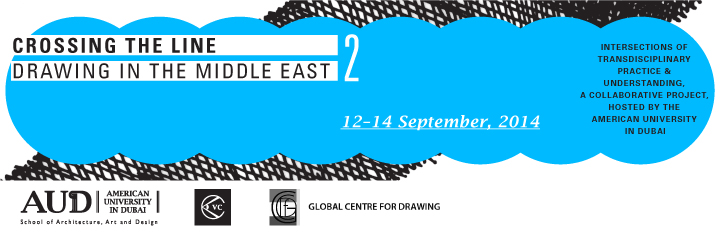Crossing the Line 2: Drawing in the Middle
East - intersections of transdisciplinary practice and
understanding will bring together specialists from various fields of research
and practices to examine the role of drawing in the contemporary Middle East and
its wider international interactions. It is hosted by the Department of Visual
Communication, in the School of Architecture, Art & Design at the American
University in Dubai, and partners with the Global Centre for Drawing, Melbourne
Australia.
Friday-Sunday,
September 12-14th 2014
With accompanying exhibitions and events.
Optional excursions on September 11th and
15th
Following the same premise as Crossing the Line 1 in November of2011, the Conference invites papers
or artist/lab talks to consider the
wider implications of drawing, from technology to ideology and cultural
practices, from art, science, music, performance and architecture. Drawing
can be considered as medium, as a tool, as notation, performance, and as a
specific mode of thinking and imagining in the processes of invention,
production, reproduction and communication within and across fields and
disciplines.
Continuum:
Crossing the Line 1
“The trans-disciplinary approach of the
conference will highlight the specificities, as well as the commonalities of
the various dimensions, fields, forms and uses of drawing, broadly defined as
the production and extension of lines in space, as the creation of meaning by
marking surfaces, as the creation and fixation of visible paths that record and
communicate patterns of temporal-spatial experiences.
In this sense, drawing is the activity
and product that makes explicit the interrelationships of flow and form in
mental life. It mediates the flux of internal processes and allows the
objectification of mental constructs and operations into practical-material as
well as perceptual-symbolic entities.
The central notion of Crossing the Line emphasizes the
act and the idea of drawing as, on one hand, the setting of clear boundaries
defining symbolic and material entities within a representational field and
representational practices, while at the same time stressing the relational
nature of all formalizing processes and constructs, of meaning making and
communicative processes in general.
In this sense, to draw is at the same
time to establish a limit and to surpass it, it is to define the interrelated
positive and negative components of any configuration. To draw is to create a
boundary that is also an interface between domains, territories, modes of thinking
and corresponding modes of being. To create a line is to produce a vector of
thought and action, and in this sense, to mark a boundary is already to cross
it, that is: drawing is a trans-formative process; it is the creation of new
paths, new relationships, new configurations of knowledge.”
Dr Marcelo Guimarães Lima, CEPAOS Research Center and University of São Paulo, Brazil
Crossing
the Line 2
The conference will examine a potentially new
nexus of drawing in the Middle East and fresh paradigms for drawing interculturally,
extending and building on the themes from 2011:
1
Drawing as a transdisciplinary practice
2
Drawing as an intersection
3
Crossing the Line: hand and technology in a changing world
4
Drawing: a portrait and landscape-notations of our time
5
Pedagogical applications
How have instructional methods evolved in light
of broader definitions of drawing in the last decade? Papers that examine
methods and theories of drawing instruction at all levels are welcome,
referencing contemporary practice, historical context, experimental projects,
etc.
6
Kinesthetics and Performance
As Paul Klee famously explained, ‘a line is a
dot that has gone for a walk.’ Drawing, by definition, requires movement,
whether physical, metaphoric, or poetic. Papers that consider kinesthetic
relationships across the spectrum from performance, dance, science, all forms
of the ‘laboratory’ are invited. Proposals may include a performance
component (there may be an opportunity for a soiree of performance drawing.
TBC)
Schedule for Proposals:
Deadline for submissions: May 1st ,
2014
Results of Selection Committee: May 7,
2014
The Selection Committee is comprised of
Dr. Irene Barberis, International Chair
Prof. Julia Townsend, Middle East Chair
Dr. Irene Barberis, International Chair
Prof. Julia Townsend, Middle East Chair
Dr. Marcelo Guimarães
Lima, Publication Chair
There
are two categories of submission for
proposals:
Papers:(25 minute presentation): An abstract of
maximum 500 words, images not required, for proposals for presentation. If
accepted, the full paper is due for Peer Review by June 1, 2014. Of all of the
accepted papers, eleven will be included in the subsequent publication and will
be informed by July 1. (There will be up to 20 presentations)
The Peer Review Team is comprised of Dr. Irene
Barberis, Dr. Marcelo Guimarães
Lima, Janet Mackenzie, Julia Townsend.
The publication will be produced by Metasenta Publications:
Dr. Irene Barberis, Executive Editor
Dr. Marcelo Guimarães Lima,
Editor
Julia Townsend, Editor
Luis Castaneda, Designer
Artist/Lab Talks (up to 30 minute
presentation): An abstract of maximum 500 words. 3 images. These presentations
will not be considered for publication.
ALL PROPOSALS MAY INCLUDE AN IMAGE (related to
the proposal) FOR CONSIDERATION IN A CONFERENCE-RELATED EXHIBITION, additional
to accompanying exhibitions already planned. Location may be on campus, near
the conference presentation room (TBA). Image may be framed or unframed, of any
2d medium, up to 42 x 59 cms, and may be delivered on the first day of the
conference. Please title this image “LastName_Firstname_4Consideration” and include title, date, size, and medium in
the image list.
Please write to:
crossingthelineconference@gmail.com
Please write to:
crossingthelineconference@gmail.com

No comments:
Post a Comment